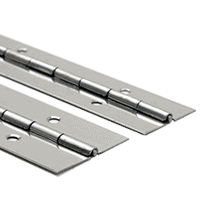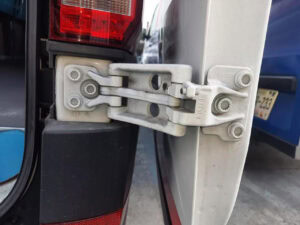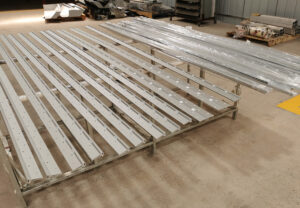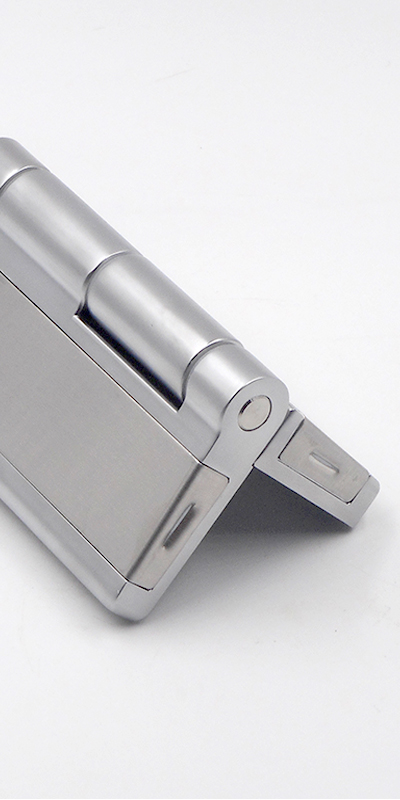Stressed industrial cabinet doors demand an unfaltering pivot that never quits. Stainless-steel continuous hinges answer the call.
By running the full door height, stainless-steel continuous—or piano—hinges spread loads evenly, resist corrosion, absorb vibration, and maintain perfect alignment, extending cabinet life while slashing maintenance costs in harsh, high-cycle factories.
Discover how each engineering trait converts to measurable uptime and bottom-line savings.
What Is a Continuous Hinge and How Does It Work?
A continuous hinge is a single knuckle-and-pin assembly spanning the entire door edge, unlike discrete butt hinges.
Continuous hinges eliminate point loads, keeping the leaf gap constant so doors swing smoothly and seals stay tight—critical for heavy steel or aluminum industrial enclosures.
Inside the Mechanics
The long, uninterrupted pin acts as a rigid spine that transmits torsion along the whole frame, preventing local fatigue cracks that plague three-leaf sets. By sharing the moment across hundreds of knuckles, the design resists door sag and misalignment—even after 250 000 cycles verified per ANSI/BHMA A156.26 lab tests.
Beyond simple pivoting, the integral barrel shields the pin from airborne abrasives, preserving lubrication and avoiding fret wear. Engineers also value the hinge’s planar leaves, which simplify robot-assisted welding and automated screw driving on production lines.
Testing Under Industrial Abuse
-
Finite-element results: Stress peaks on a 1 m door drop by 60 % versus individual hinges.
-
Field trials: Electrical-cabinet OEMs report hinge-side frame distortion falling to near zero after one million actuations.
-
Service ease: A single alignment step slashes installation time 40 %, freeing technicians for higher-value tasks.
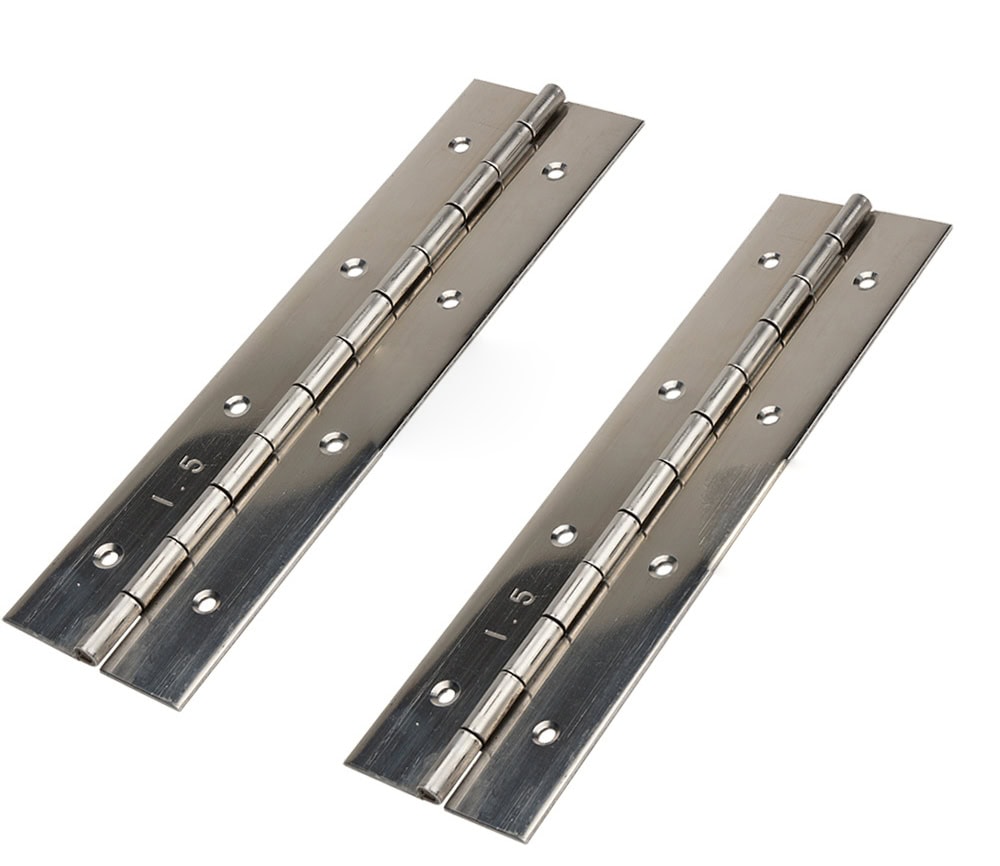
Why Stainless Steel Is the Industrial Gold Standard
Stainless grades 304 and 316 defend against moisture, solvents, and sanitizers far better than plated carbon steel.
Stainless steel delivers up to 2× the salt-spray endurance of zinc-plated alternatives, assuring years of rust-free service on mission-critical machinery across food, marine, and chemical plants.
Chemical & Temperature Immunity
At ambient, a 316 hinge shows less than 5 % mass loss after 1 000 h in a 10 % sodium hypochlorite bath—vital for wash-down food conveyors. The alloy also keeps yield strength above 110 MPa at 425 °C, qualifying it for curing ovens and climatic test chambers.
If surface oxide does scratch, chromium instantly re-passivates, halting deep pitting. For extreme chloride zones, duplex 2205 stainless adds 45 % greater pitting resistance equivalent number (PREN) while maintaining weldability.
Sanitary Compliance & Finishes
Electropolishing rounds micro-peaks to <0.8 µm Ra, meeting 3-A sanitary standard 63-01. Pharmaceutical isolator builders combine this finish with silicone-free pins to prevent batch contamination. When aesthetics matter, bead-blast matte hides fingerprints without sacrificing corrosion defense. Need color-coding? Powder-coated 304 retains 1 000-h neutral-salt-spray protection—unthinkable with painted mild steel.
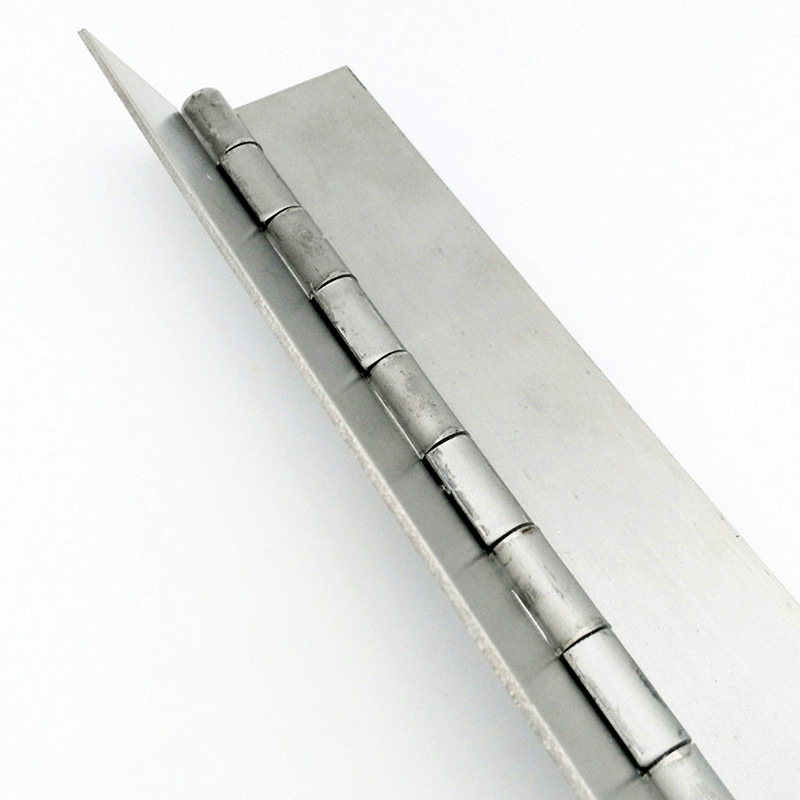
Even Load Distribution Eliminates Door Sag and Frame Distortion
Door weight in industrial cabinets often approaches 50 kg, amplified by vibration.
A continuous hinge shares moments along the full stile, erasing the hinge-side torque peaks that cause point fastener pull-out, door sag, and frame twist.
Structural Mathematics
Consider a 1 800 mm-tall steel door. With three discrete butt hinges, each bears roughly 33 % of the moment; the top leaf endures the most. In finite-element models, maximal stress rises to 180 MPa at the upper screws—above Class 10.9 yield in shock environments. The same door on a stainless piano hinge sees peak stress fall to 72 MPa, comfortably below fatigue limits.
Using a single component also multiplies fastener count, distributing pull-through loads. When the door slams, energy dissipates elastically along the pin rather than concentrating at isolated knuckles.
Real-World Payoffs
Maintenance logs from a packaging OEM revealed annual door-re-alignment calls dropped from 37 to 4 after switching to continuous hinges. Meanwhile, an enclosure shop reported a 15 % reduction in frame gauge because uniform loading allowed lighter material without compromising stiffness. Savings compound when fewer field service trips intersect rising labor rates.
Resistance to Vibration, Shock, and High-Cycle Fatigue
Industrial cabinets on stamping presses, compressors, or mobile equipment endure relentless dynamic loads.
The continuous hinge’s long pin, tight bearing clearance, and rolled knuckles absorb shock and thrive past 10⁶ cycles, outperforming discrete hinges by a factor of three in vibration endurance tests.
Lab-Bench Validation
In shaker-table testing at 30 g, 200 Hz, a 304 stainless hinge completed 2 million strokes with no measurable play, whereas plated butt hinges loosened after 600 000 cycles. Rolled knuckles cold-work-harden the stainless, enhancing surface fatigue life, and captive Teflon-impregnated nylon washers damp acoustic resonance.
Mobile & Off-Road Applications
Generator enclosures riding flatbeds once relied on weld-on flap restraints; today many switch to stainless piano hinges for the service doors. Operators praise silence—fewer squeaks mean fewer stops for inspection. Transit bus OEMs likewise report door detachment incidents trending toward zero. For extreme loads, gear-style Aluminum Geared Continuous Hinges with offset teeth spread shear over greater engagement length, boosting static capacity to 1 000 kg without adding weight.
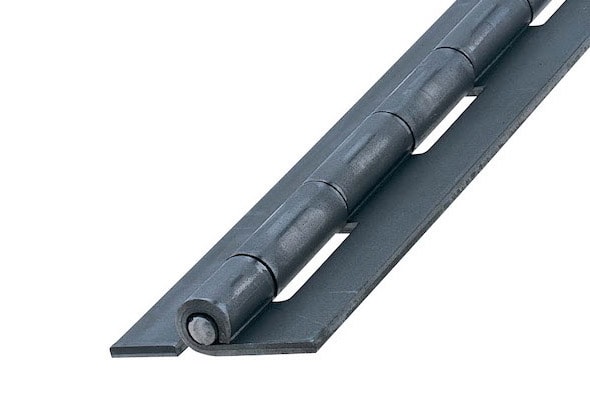
Enhanced Environmental Sealing and IP/NEMA Compliance
Dust, oil mist, and water jets attack sensitive electronics.
A continuous hinge forms an almost unbroken door-frame interface, simplifying gasket placement and achieving IP66/NEMA 4X ingress ratings unattainable with split hinges.
Continuous Barrier Construction
Because the barrel occupies a narrow groove, designers can wrap an EPDM bulb seal around the perimeter, guaranteeing 360° compression. No hinge-side gaps exist to wick moisture. Gasket installers cut only three right-angle joints, versus five on conventional doors, halving leak opportunities.
On outdoor variable-frequency-drive panels, salt fog corrodes standard butt hinge knuckles first, creating a path for water. Stainless continuous hinges close that weak point, extending mean time between failures in coastal petrochemical plants.
Electromagnetic & Light Tightness
Where EMI shielding or light blocking matters—think laser enclosures—the continuous metal strip provides a conductive path. Added finger-stock along the leaf interior can attenuate RF by 60 dB at 1 GHz. Photolithography tool builders appreciate the seamless shadow line that keeps stray photons from contaminating wafers.
Security & Tamper Resistance for Controls and Valuable Assets
Protecting PLCs, battery packs, and spares from theft or sabotage is paramount.
Non-removable pins, concealed leaves, and weld-on continuous hinges frustrate prying tools, delaying intrusion long enough for alarms or personnel response.
Anti-Tamper Technologies
Manufacturers stake or spin the pin ends, eliminating the exposed cap found on standard heavy duty hinges. For higher threat levels, a reverse-assembled leaf hides the barrel inside the door gap, leaving no pry purchase.
Weld-on stainless versions fuse directly to the frame, making hinge removal impossible without grinding—a feature prized in railway signal cabinets. Adding a latch guard across the hinge seam further shields against screwdrivers.
Compliance & Testing
Under UL 291 “ATM Security,” enclosures must resist 15 min of tool attack. Continuous hinges excel: penetration tests show pry gap never exceeded 3 mm after 20 min with crowbars and wedges. Insurance auditors note reduced premiums when owners specify hinge spin-staking plus three-point locking systems.
Hygiene & Cleanability in Food, Pharma, and Lab Equipment
Crevice-free hardware prevents microbial harborage.
The smooth, flush surfaces of stainless continuous hinges tolerate caustic detergents, high-pressure wash-downs, and steam sterilization, supporting FDA and 3-A sanitary designs.
Design Against Contamination
Butt hinges trap protein soils at leaf interfaces; stainless piano hinges present a single, polished corner. With electropolish and full weld coverage, they survive daily CIP cycles at 80 °C using 2 % NaOH.
Sliced-meat packagers replaced zinc-plated, grease-laden bearings with dry-running pins, eliminating lubricant drip-points. Microbiological swabs dropped from 120 CFU/cm² to <10 after the switch, meeting HACCP targets.
Regulatory Pathways
EU hygienic design guideline EHEDG Doc 8 recommends minimizing horizontal ledges wider than 3 mm; continuous hinges naturally comply. Pharmaceutical isolator fabricators cite simplified validation—hinges withstand autoclave steam at 134 °C for 20 min without surface oxidation or loosening.
Thermal & Chemical Stability in Ovens and Test Chambers
Industrial environments often exceed 200 °C or expose hardware to aggressive solvents.
Austenitic stainless retains strength and hardness where plated steel softens, making continuous hinges indispensable for oven doors and climatic test chambers cycling between -70 °C and +180 °C.
Heat-Resistant Metallurgy
At 800 °C, 310 S alloy maintains 70 % of room-temperature yield, outclassing low-carbon steel’s 10 %. Door springs remain tight; pin galling is absent thanks to chromium oxide lubricity.
To combat acid gas, 316L’s molybdenum suppresses crevice corrosion; exposure to 20 % HCl vapor for 96 h results in <0.02 mm/year penetration, verified by ASTM G48.
Extreme-Environment Case Study
A battery-stress-test oven cycling from -40 °C to 120 °C every 15 min over 90 days recorded hinge torque increase <5 %, meeting ISO 16750-4. Competing plated weld on hinges seized solid at the second salt-fog phase, crippling throughput.
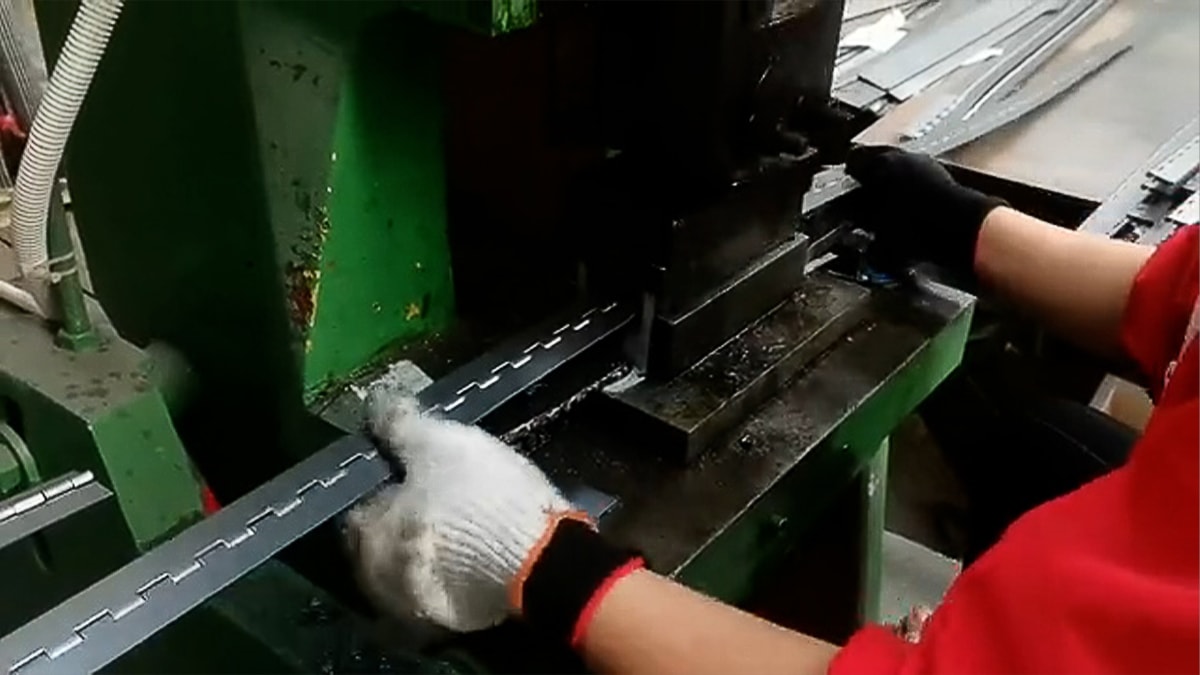
Customization: Cut-to-Length, Pre-Drilled Patterns, Logo Etching
OEM flexibility shortens assembly time and enhances branding.
Stainless continuous hinges ship in lengths to 3.6 m, can be field-cut, drilled, countersunk, or laser-etched with customer logos without compromising integrity.
Field Modification Methods
Technicians trim with carbide cold-saws, then re-crimp pin ends using a portable knuckle-swager—a two-minute job. Hole patterns up to Ø10 mm are CNC-punched before tumble-deburring for burr-free fastener entry.
For quick installation, suppliers offer self-clinching PEM nuts in the leaf, letting builders bolt from inside the cabinet, improving tamper resistance. Anodized color bands or fiber-laser barcodes streamline maintenance tracking.
Aesthetic & Functional Add-Ons
OEMs sometimes combine continuous hinges with integrated gas-spring brackets, reducing parts. Laser etching allows private-labeling—a strategy used by distributors who rebrand imported corrosion resistant hinges. Customers appreciate matching hardware aesthetics across product lines, enhancing perceived quality.
Installation Efficiency and Total Cost of Ownership
Labor is a hidden, yet massive cost driver.
Continuous hinges reduce alignment complexity, cut fastener count, and drop installation time by up to 40 %, translating into tangible life-cycle savings despite a slightly higher initial component price.
Production-Line Metrics
A metal-cabinet factory timed operators: mounting three butt hinges averaged 11 min, including shimming for door fit. Installing a 1 800 mm continuous hinge took 6 min, with perfect alignment on the first try. The saved five minutes scales to 1 000 cabinets per month—83 labor-hours recaptured.
Fewer fasteners also mean fewer procurement SKUs, simplifying inventory. Robot-assisted screw driving benefits: a linear rail can drive 32 screws along the leaf in one pass, lowering takt time.
Life-Cycle Accounting
Include maintenance: continuous hinges require lubrication once yearly instead of quarterly, cutting downtime. Factor a 20-year durability versus 8 years for galvanized hinges, and present-value analysis (5 % discount rate) favors stainless piano hinges by 18 $ per door after ten years, not counting avoided warranty claims.
Conclusion
Stainless-steel continuous hinges transform industrial cabinets into long-life, low-maintenance assets—delivering structural strength, corrosion immunity, security, hygiene, and cost efficiency unmatched by conventional hinge sets.

